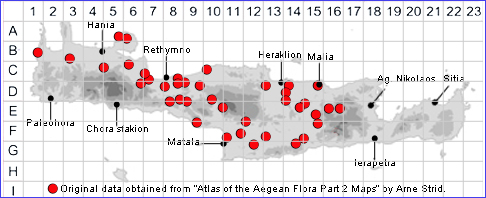
CREPIS SANCTA
Family and Genus:- See- COMPOSITAE/Sect. PTEROTHECA
Common Names:- None
Homotypic Synonyms:- Hieracium sanctum, Lagoseris sancta, Pterotheca
sancta.
Meaning:- Crepis (Gr) A name used by Greek philosopher Theophrastus.
Sancta (L) Holy, sacred, chaste.
General description:- Pubescent annuals with slender roots
Stems:-
1) 10-40 cm, many.
Leaves:-
1) With short, yellow, simple eglandular hairs, or subglabrous.
a) basal, 1-20 x 0·5-4 cm, obovate, oblanceolate or spathulate, obtuse to acute,
denticulate, runcinate-pinnatifid or lyrate.
b) cauline, few, linear or bract-like.
Flowers:-
1) Receptacle, with long white rigid hairs, subtending the florets.
2) Involucre, 6-11 x 4-9 mm.
a) outer bracts, lanceolate, with conspicuous pale margin, 1/8-1/3 as long as the
inner.
b) inner bracts, linear-lanceolate, acute; all more or less tomentose and with
dark or pale, simple eglandular hairs, with or without glandular hairs, or
glabrous.
3) Ligules, yellow to deep yellow.
Fruit:-
1) Achenes, of 3 kinds:
a) outermost, narrowly fusiform, sometimes somewhat compressed (sometimes
absent).
b) intermediate, fusiform, spinulose.
c) inner, fusiform, smooth.
Key features:-
1) Outer phyllaries, up to a 1/3 as long as the inner.
2) Receptacle, with rigid hairs subtending the florets.
Habitat:- Coastal habitats, dry grassland, open shrubby vegetation, fallow fields,
olive groves. 0-1500 m.
Distribution:- Throughout Greece, C & E Mediterranean area, widespread in SW
Asia. On Crete fairly widespread but mainly central and to the west.
Flowering time:- Mar-June.
Photos by:- Zacharias Angourakis
SPECIES DESCRIPTION
